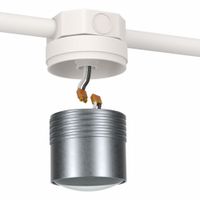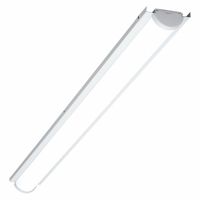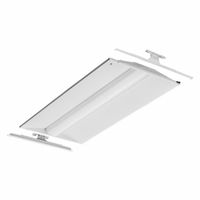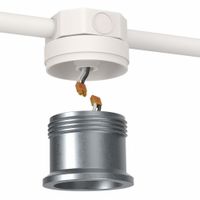Call +(254) 703 030 000 / 751 483 999 / 721 704 777
- Home
- Lighting
- Lighting Fixtures Retrofit Kits
- Retrofit Kits Led Upgrade Kits
.....Read More
Frequently Asked Questions
What are the benefits of using LED retrofit kits?
LED retrofit kits offer several benefits:
1. **Energy Efficiency**: LED retrofit kits consume significantly less energy compared to traditional lighting systems, leading to reduced electricity bills and a lower carbon footprint.
2. **Cost Savings**: Although the initial investment might be higher, the long-term savings on energy costs and reduced maintenance expenses make LED retrofits economically advantageous.
3. **Long Lifespan**: LEDs have a longer operational life, often lasting up to 50,000 hours or more, which reduces the frequency and cost of replacements.
4. **Improved Light Quality**: LED retrofit kits provide better light quality with higher color rendering index (CRI), enhancing visibility and creating a more pleasant environment.
5. **Environmental Benefits**: LEDs contain no hazardous materials like mercury, making them safer for the environment. They also reduce greenhouse gas emissions due to lower energy consumption.
6. **Versatility**: LED retrofit kits are available in various sizes and configurations, making them suitable for a wide range of applications, from residential to commercial and industrial settings.
7. **Easy Installation**: These kits are designed for straightforward installation, often fitting into existing fixtures without the need for extensive modifications.
8. **Dimmability and Control**: Many LED retrofit kits offer dimming capabilities and can be integrated with smart controls, allowing for customizable lighting solutions and further energy savings.
9. **Heat Reduction**: LEDs emit less heat compared to traditional lighting, reducing the load on air conditioning systems and enhancing comfort.
10. **Incentives and Rebates**: Many regions offer incentives and rebates for upgrading to energy-efficient lighting, which can offset the initial cost of LED retrofit kits.
Overall, LED retrofit kits provide a sustainable, cost-effective, and high-quality lighting solution that benefits both users and the environment.
How do I choose the right retrofit kit for my existing fixtures?
To choose the right retrofit kit for your existing fixtures, follow these steps:
1. **Identify Fixture Type**: Determine the type of fixture you have (e.g., recessed lighting, fluorescent tubes, or high bay fixtures). This will guide you to the appropriate retrofit kit.
2. **Check Compatibility**: Ensure the retrofit kit is compatible with your fixture's size and shape. Measure the fixture dimensions and compare them with the kit specifications.
3. **Determine Lighting Needs**: Assess the desired brightness (lumens) and color temperature (Kelvin) for your space. Retrofit kits come in various outputs and temperatures to suit different environments.
4. **Consider Energy Efficiency**: Look for kits with high energy efficiency ratings. LED retrofit kits are typically more efficient than traditional lighting, offering significant energy savings.
5. **Evaluate Installation Requirements**: Some kits are designed for easy installation, while others may require professional help. Choose a kit that matches your installation skills or budget for professional installation.
6. **Check for Dimmability**: If you need dimmable lighting, ensure the retrofit kit is compatible with your existing dimmer switches or consider upgrading to compatible dimmers.
7. **Review Certifications and Standards**: Look for kits with certifications like ENERGY STAR or DLC, which ensure quality and efficiency. Compliance with local electrical codes is also crucial.
8. **Consider Longevity and Warranty**: Check the expected lifespan of the retrofit kit and the warranty offered. Longer lifespans and warranties indicate better quality and reliability.
9. **Budget Considerations**: Compare prices of different kits, but also consider long-term savings from reduced energy consumption and maintenance costs.
10. **Seek Professional Advice**: If unsure, consult with a lighting professional or electrician to ensure you select the best retrofit kit for your needs.
Are LED retrofit kits compatible with all types of fixtures?
LED retrofit kits are not universally compatible with all types of fixtures. Compatibility depends on several factors:
1. **Fixture Type**: LED retrofit kits are designed for specific fixture types, such as recessed cans, troffers, or streetlights. Each type has unique dimensions and requirements, so a kit must match the fixture's design.
2. **Size and Shape**: The physical dimensions of the retrofit kit must fit within the existing fixture. Some fixtures may have space constraints that prevent the installation of certain kits.
3. **Wattage and Lumen Output**: The electrical specifications of the retrofit kit must align with the fixture's capacity. Overloading a fixture with a kit that requires more power than the fixture can handle can lead to overheating or failure.
4. **Socket Compatibility**: The retrofit kit must be compatible with the fixture's socket type. Common socket types include E26, GU24, and others. Adapters may be available, but they can complicate installation and affect performance.
5. **Voltage Requirements**: The voltage requirements of the retrofit kit must match the fixture's supply. Mismatched voltages can cause malfunction or damage.
6. **Thermal Management**: LED kits generate heat, and the fixture must be able to dissipate this heat effectively. Inadequate thermal management can reduce the lifespan of the LEDs.
7. **Regulatory Compliance**: Some fixtures may have specific regulatory requirements, such as UL or Energy Star ratings, which the retrofit kit must meet.
8. **Aesthetic and Functional Considerations**: The retrofit kit should maintain the fixture's intended aesthetic and functional characteristics, such as light distribution and color temperature.
Before purchasing a retrofit kit, it's essential to verify compatibility with the existing fixture by consulting the manufacturer's specifications or seeking professional advice.
How do I install an LED retrofit kit?
1. **Turn Off Power**: Switch off the power to the fixture at the circuit breaker to ensure safety.
2. **Remove Existing Fixture**: Detach the existing light fixture by unscrewing it from the ceiling or wall. Carefully disconnect the wires by unscrewing the wire nuts.
3. **Prepare the Retrofit Kit**: Unpack the LED retrofit kit and read the manufacturer's instructions. Ensure all components are present.
4. **Install Mounting Bracket**: If the kit includes a mounting bracket, attach it to the electrical box using the provided screws.
5. **Connect Wires**: Match the wires from the retrofit kit to the wires in the electrical box—typically black to black (hot), white to white (neutral), and green or bare to ground. Secure connections with wire nuts.
6. **Attach Retrofit Kit**: Secure the LED retrofit kit to the mounting bracket or directly to the electrical box, as per the instructions. Ensure it is firmly in place.
7. **Install LED Module**: If the kit includes a separate LED module, connect it to the fixture according to the instructions, usually by snapping or screwing it into place.
8. **Secure Trim**: Attach any trim or cover that comes with the kit to complete the installation. This may snap or screw into place.
9. **Restore Power**: Turn the power back on at the circuit breaker and test the light to ensure it functions correctly.
10. **Adjust Settings**: If the retrofit kit includes adjustable settings (e.g., color temperature or brightness), adjust them as desired.
11. **Dispose of Old Fixture**: Properly dispose of the old fixture and any packaging materials from the retrofit kit.
What is the cost difference between retrofitting and replacing fixtures?
The cost difference between retrofitting and replacing fixtures can vary significantly based on several factors, including the type of fixture, the complexity of the installation, and the specific requirements of the project.
Retrofitting typically involves updating or modifying existing fixtures to improve efficiency or functionality. This process is generally less expensive than replacing fixtures because it often requires fewer materials and less labor. Retrofitting can include actions like installing LED bulbs in existing light fixtures or adding low-flow aerators to faucets. The cost savings come from utilizing the existing infrastructure and minimizing waste.
On the other hand, replacing fixtures involves removing the old fixtures and installing new ones. This process can be more costly due to the need for new materials and potentially more extensive labor. Replacement might be necessary if the existing fixtures are outdated, damaged, or incompatible with new technologies. While the initial costs are higher, replacement can offer long-term savings through improved efficiency and reduced maintenance needs.
In summary, retrofitting is generally more cost-effective upfront, especially for minor updates or when the existing fixtures are in good condition. Replacement, while more expensive initially, may be more beneficial in the long run if the existing fixtures are inefficient or nearing the end of their lifespan. The decision between retrofitting and replacing should consider both immediate budget constraints and long-term benefits.
How long do LED retrofit kits typically last?
LED retrofit kits typically last between 50,000 to 100,000 hours. This lifespan can vary based on several factors, including the quality of the components, the operating environment, and how well the system is maintained. High-quality LED retrofit kits, which use superior materials and advanced technology, tend to be more durable and efficient, often reaching the upper end of the lifespan range.
The operating environment plays a crucial role in determining the longevity of LED retrofit kits. Kits installed in areas with extreme temperatures, high humidity, or poor ventilation may experience reduced lifespans due to increased thermal stress. Proper heat management is essential, as excessive heat can degrade the LED components and reduce their efficiency over time.
Maintenance is another critical factor. Regular cleaning and inspection can help ensure that the LED retrofit kits operate efficiently and last longer. Dust and debris accumulation can obstruct heat dissipation, leading to overheating and premature failure.
LED retrofit kits are designed to replace traditional lighting systems, offering energy efficiency and reduced maintenance costs. They are commonly used in commercial, industrial, and residential settings to upgrade existing fixtures without the need for complete replacement. The long lifespan of LED retrofit kits makes them a cost-effective solution, as they require fewer replacements and consume less energy compared to traditional lighting options.
In summary, while the typical lifespan of LED retrofit kits ranges from 50,000 to 100,000 hours, achieving the maximum lifespan depends on the quality of the kit, the conditions in which it operates, and the level of maintenance it receives.
Can LED retrofit kits be used in outdoor fixtures?
Yes, LED retrofit kits can be used in outdoor fixtures, provided they are designed for outdoor use. When selecting an LED retrofit kit for outdoor applications, it is crucial to ensure that the kit is rated for outdoor conditions. This typically means the kit should have an appropriate Ingress Protection (IP) rating, which indicates its resistance to dust and moisture. An IP65 rating or higher is generally recommended for outdoor use to ensure the kit can withstand rain and other environmental factors.
Additionally, the retrofit kit should be compatible with the existing fixture in terms of size, shape, and electrical requirements. It is important to verify that the kit can operate within the voltage and current specifications of the existing fixture. The thermal management of the LED retrofit kit is also a critical consideration, as outdoor environments can experience significant temperature fluctuations. Proper heat dissipation mechanisms, such as heat sinks, are necessary to maintain the longevity and performance of the LEDs.
Furthermore, the color temperature and brightness of the LED retrofit kit should be suitable for the intended outdoor application, whether it is for street lighting, parking lots, or landscape lighting. Some kits offer adjustable color temperatures and dimming capabilities, which can enhance the versatility of the lighting setup.
Finally, compliance with local regulations and standards for outdoor lighting is essential. This may include considerations for light pollution, energy efficiency, and safety standards. By ensuring these factors are addressed, LED retrofit kits can be effectively and safely used in outdoor fixtures, providing energy-efficient and long-lasting lighting solutions.




